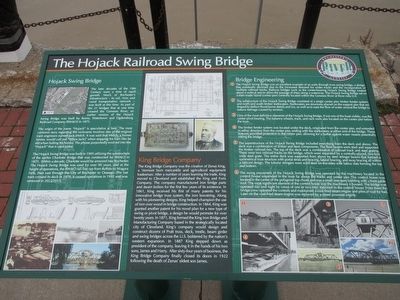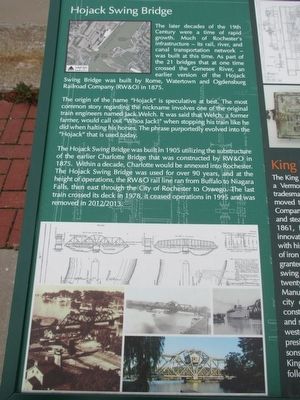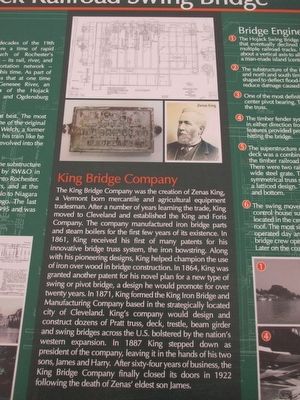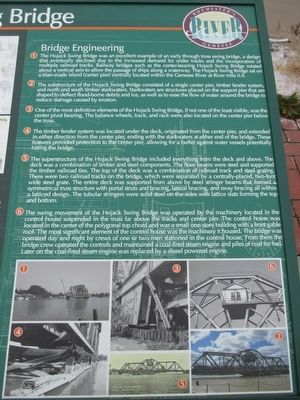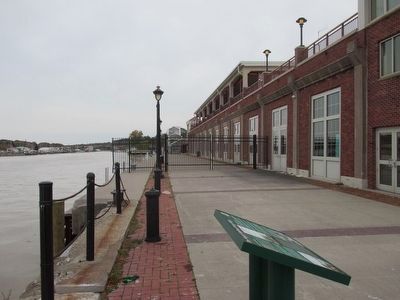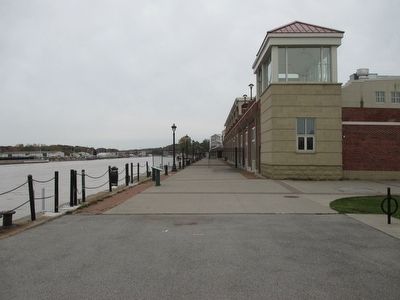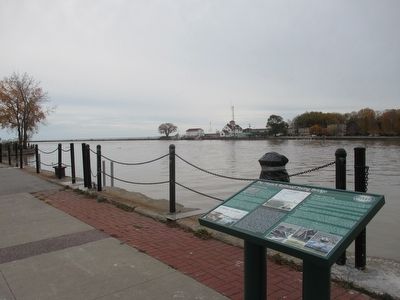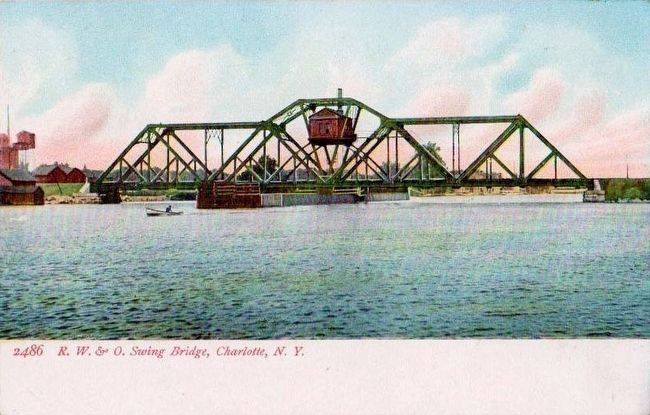Charlotte in Rochester in Monroe County, New York — The American Northeast (Mid-Atlantic)
The Hojack Railroad Swing Bridge
Rochester's Genesee River
Hojack Swing Bridge
The later decades of the 19th Century were a time of rapid growth. Much of Rochester's infrastructure - its rail, river, and canal transportation network - was built at this time. As part of the 21 bridges that at one time crossed the Genesee River, an earlier version of the Hojack Swing Bridge was built by Rome, Watertown and Ogdensburg Railroad Company (RW&O) in 1875.
The origin of the name "Hojack" is speculative at best. The most common story regarding the nickname involves one of the original train engineers named Jack Welsh. It was said that Welsh, a former farmer, would call out "Whoa Jack!" when stopping the train like he did when halting his horses. The phrase purportedly evolved into the "Hojack" that is used today.
The Hojack Swing Bridge was built in 1905 utilizing the substructure of the earlier Charlotte Bridge that was constructed by RW&O in 1875. Within a decade, Charlotte would be annexed into Rochester. The Hojack Swing Bridge was used for over 90 years, and at the height of operations, the RW&O rail line ran from Buffalo to Niagara Falls, then east through the City of Rochester to Oswego. The last train crossed its deck in 1978, it ceased operations in 1995 and was removed in 2012/2013.
King Bridge Company
The King Bridge Company was the creation of Zenas King, a Vermont born mercantile and agricultural equipment tradesman. After a number of years learning the trade, King moved to Cleveland and established the King and Foris Company. The company manufactured iron bridge parts and steam boilers for the first few years of its existence. In 1861, King received his first of many patents for his innovative bridge truss system, the iron bowstring. Along with his pioneering designs, King helped champion the use of iron over wood in Bridge construction. In 1864, King was granted another patent for his novel plan for a new type of swing or pivot bridge, a design he would promote for over twenty years. In 1871, King formed the the King Iron Bridge and Manufacturing Company based in the strategically located city of Cleveland. King's company would design and construct dozens of Pratt truss, deck, trestle, beam girder and swing bridges across the U.S. bolstered by the nation's western expansion. In 1887 King stepped down as president of the company, leaving it in the hands of his two sons, James and Harry. After sixty-four years of business, the King Bridge Company finally closed its doors in 1922 following the death of Zenas' eldest son James.
Bridge Engineering
1) The Hojack Swing Bridge was an excellent example of an early through truss swing bridge, a design that eventually declined due to the increased demand for wider tracks and the incorporation of multiple railroad tracks. Railway bridges such as the center-bearing Hojack Swing Bridge rotated about a vertical axis to allow the passage of ships along a waterway. The Hojack Swing Bridge sat on a man-made island (center pier) centrally located within the Genesee River at River mile 0.9.
2) The substructure of the Hojack Swing Bridge consisted of a single center pier, timber fender system, and north and south timber starkwaters. Starkwaters are stuctures placed on the support pier that are shaped to deflect flood-borne debris and ice, as well as to ease the flow of water around the bridge to reduce damage caused by erosion.
3) One of the most definitive elements of the Hojack Swing Bridge, if not one of the least visible, was the center pivot bearing. The balance wheels, track, and rack were also located on the center pier below the truss.
4) The timber fender system was located under the deck, originated from the center pier, and extended in either direction from the center pier, ending with the starkwaters at either end of the bridge. These features provided protection to the center pier, allowing for a buffer against water vessels potentially hitting the bridge.
5) The superstructure of the Hojack Swing Bridge included everything from the deck and above. The deck was a combination of timber and steel components. The floor beams were steel and supported the timber railroad ties. The top of the deck was a combination of railroad track and steel grating. There were two railroad tracks on the bridge, which were separated by a centrally-placed, two-foot wide steel grate. The entire deck was supported from above by steel stringer beams that formed a symmetrical truss structure with portal struts and bracing, lateral bracing, and sway bracing all within a latticed design. The tubular stringers were solid steel on the sides with lattice slats forming the top and bottom.
6) The swing movement of the Hojack Swing Bridge was operated by the machinery located in the control house suspended on the truss far above the tracks and center pier. The control house was located in the center of the polygonal top chord and was a small one-story building with a front gable roof. The most significant element of the control house was the machinery it housed. The bridge was operated day and night by crews of one or two men stationed in the control house. From there the bridge crew operated the controls and maintained a coal-fired steam engine and piles of coal for fuel. Later on the coal-fired steam engine was replaced by a diesel powered engine.
Topics. This historical marker is listed in these topic lists: Bridges & Viaducts • Railroads & Streetcars. A significant historical year for this entry is 1875.
Location. 43° 15.359′ N, 77° 36.396′ W. Marker is in Rochester, New York, in Monroe County. It is in Charlotte. Marker can be reached from Corrigan Street. Marker is on the Genesee River riverside walkway by the northeast corner of the Port of Rochester building. Access to the marker, building, and parking lots is via Corrigan Street off of Lake Avenue. Touch for map. Marker is at or near this postal address: 1000 North River Street, Rochester NY 14612, United States of America. Touch for directions.
Other nearby markers. At least 8 other markers are within walking distance of this marker. In Honor of the Crew of USS Liberty (about 500 feet away, measured in a direct line); Battle of the Bulge (approx. 0.2 miles away); Merchant Ship to Warship (approx. 0.2 miles away); 1822 Lighthouse (approx. 0.3 miles away); Charlotte-Genesee Lighthouse (approx. 0.3 miles away); Latta House (approx. half a mile away); Lighthouses (approx. half a mile away); Resort Area (approx. half a mile away). Touch for a list and map of all markers in Rochester.
More about this marker. The Port of Rochester building was constructed for the short-lived revival of a ferry. The ferry ran between here and Toronto.
Also see . . .
1. Rome, Watertown and Ogdensburg Railroad - Wikipedia. (Submitted on November 19, 2015, by Anton Schwarzmueller of Wilson, New York.)
2. King Bridge Museum Website. (Submitted on November 19, 2015, by Anton Schwarzmueller of Wilson, New York.)
Credits. This page was last revised on February 16, 2023. It was originally submitted on November 19, 2015, by Anton Schwarzmueller of Wilson, New York. This page has been viewed 821 times since then and 107 times this year. Photos: 1, 2, 3, 4, 5, 6, 7. submitted on November 19, 2015, by Anton Schwarzmueller of Wilson, New York. 8. submitted on November 22, 2015.
